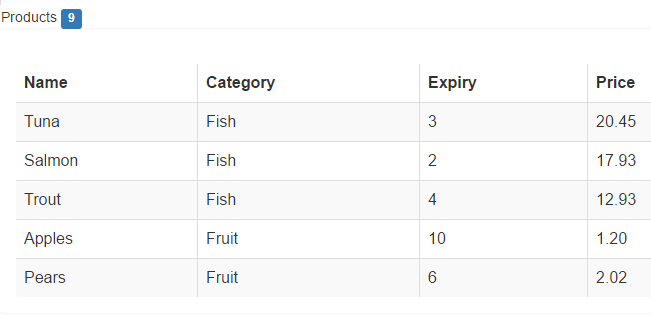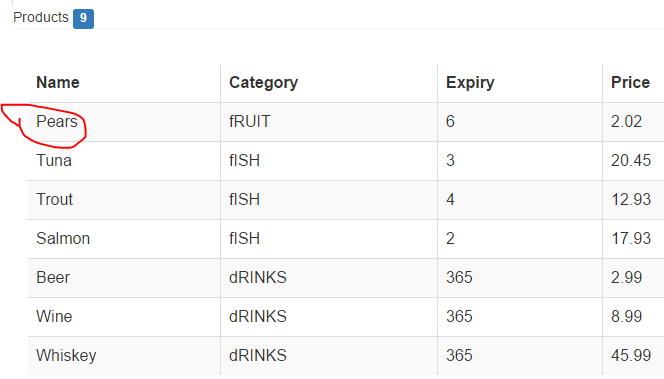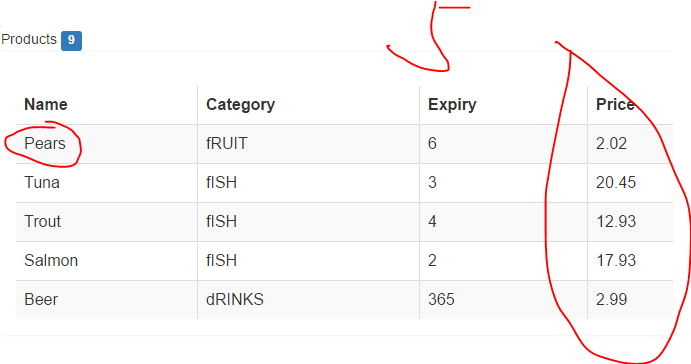这篇文章给大家分享的是有关AngularJS怎么使用过滤器的内容。小编觉得挺实用的,因此分享给大家做个参考,一起跟随小编过来看看吧。
一、为什么使用过滤器?
在实际操作中,我们需要对统一数据源进行多次转换,比如我的货币单位,在不同的国家我们将用不同的符号表示。因此,你可能会想到在控制器中判断国家以显示不同的结果,但是过滤器却可以更好的帮助我们做到同样的效果。
过滤器将数据在被指令处理并显示到视图之前进行转换,而不必修改作用域中原有的数据,这样能够允许同一份数据在应用中的不同部分以不同形式得以展示。
接下来,我们详细讨论有关过滤器的用法
二、过滤单个数据的值
下表展示用于单个数据的内置过滤器

先来看看我们的准备案例,待会我们将在这个案例的基础上来使用内容过滤器
<!DOCTYPE>
<!-- use module -->
<html ng-app="exampleApp">
<head>
<title>Angluar test</title>
<meta charset="utf-8"/>
<link rel="stylesheet" type="text/css" href="css/bootstrap.min.css" rel="external nofollow" rel="external nofollow" rel="external nofollow" rel="external nofollow" rel="external nofollow" rel="external nofollow" >
<link rel="stylesheet" type="text/css" href="css/bootstrap-theme.min.css" rel="external nofollow" rel="external nofollow" rel="external nofollow" rel="external nofollow" rel="external nofollow" rel="external nofollow" >
</head>
<body>
<dlv class="panel panel-default" ng-controller="defaultCtrl">
<div class="panel panel-header">
Products
<span class="label label-primary">{{products.length}}</span>
</div>
<div class="panel panel-body">
<table class="table table-striped table-bordered table-hover">
<thead>
<tr><th>Name</th><th>Category</th><th>Expiry</th><th>Price</th></tr>
</thead>
<tbody>
<tr ng-repeat="p in products">
<td>{{p.name}}</td>
<td>{{p.category}}</td>
<td>{{p.expiry}}</td>
<td>{{p.price}}</td>
</tr>
</tbody>
</table>
</div>
</dlv>
<script type="text/javascript" src="js/angular.min.js"></script>
<script type="text/javascript">
var myApp = angular.module("exampleApp", []);
myApp.controller("defaultCtrl", function ($scope) {
$scope.products = [
{ name: "Apples", category: "Fruit", price: 1.20, expiry: 10 },
{ name: "Bananas", category: "Fruit", price: 2.42, expiry: 7 },
{ name: "Pears", category: "Fruit", price: 2.02, expiry: 6 },
{ name: "Tuna", category: "Fish", price: 20.45, expiry: 3 },
{ name: "Salmon", category: "Fish", price: 17.93, expiry: 2 },
{ name: "Trout", category: "Fish", price: 12.93, expiry: 4 },
{ name: "Beer", category: "Drinks", price: 2.99, expiry: 365 },
{ name: "Wine", category: "Drinks", price: 8.99, expiry: 365 },
{ name: "Whiskey", category: "Drinks", price: 45.99, expiry: 365 }
];
})
</script>
</body>
</html>就是一个表格的形式来展示产品的详细情况的案例

1.格式化货币值
<tr ng-repeat="p in products">
<td>{{p.name}}</td>
<td>{{p.category}}</td>
<td>{{p.expiry}}</td>
<!-- 使用currency -->
<td>{{p.price | currency}}</td>
</tr>
2.格式化数字值
<tr ng-repeat="p in products">
<td>{{p.name}}</td>
<td>{{p.category}}</td>
<td>{{p.expiry}}</td>
<!-- 保留小数点后3位 -->
<td>{{p.price | number : 3}}</td>
</tr>
3.格式化日期
// 在控制器中添加
$scope.getExpiryDate = function (days) {
var now = new Date();
return now.setDate(now.getDate() + days);
}<tr ng-repeat="p in products">
<td>{{p.name}}</td>
<td>{{p.category}}</td>
<!-- 在视图中使用-->
<td>{{getExpiryDate(p.expiry) | date : 'yyyy/MM/dd'}}</td>
<!-- 货币单位本地化 -->
<td>{{p.price}}</td>
</tr>
4.改变字符串大小写
<tr ng-repeat="p in products">
<!-- 字母大小写 -->
<td>{{p.name | uppercase}}</td>
<td>{{p.category | lowercase}}</td>
<td>{{getExpiryDate(p.expiry) | date : 'yyyy/MM/dd'}}</td>
<!-- 货币单位本地化 -->
<td>{{p.price}}</td>
</tr>
5.生成JSON
<tr ng-repeat="p in products">
<!-- 生成JSON数据 -->
<td>{{p.name | json}}</td>
<td>{{p.category}}</td>
<td>{{getExpiryDate(p.expiry) | date : 'yyyy/MM/dd'}}</td>
<!-- 货币单位本地化 -->
<td>{{p.price}}</td>
</tr>
6.本地化过滤器输出
需要移入本地化JS文件
<!-- 引入本地化文件 --> <script type="text/javascript" src="js/angular-locale_zh-cn.js"></script>
<tr ng-repeat="p in products">
<td>{{p.name}}</td>
<td>{{p.category}}</td>
<td>{{p.expiry}}</td>
<!-- 货币单位本地化 -->
<td>{{p.price | currency}}</td>
</tr>
三、过滤集合
1.限制项目的数量—limitTo过滤器
<!DOCTYPE>
<!-- use module -->
<html ng-app="exampleApp">
<head>
<title>Angluar test</title>
<meta charset="utf-8"/>
<link rel="stylesheet" type="text/css" href="css/bootstrap.min.css" rel="external nofollow" rel="external nofollow" rel="external nofollow" rel="external nofollow" rel="external nofollow" rel="external nofollow" >
<link rel="stylesheet" type="text/css" href="css/bootstrap-theme.min.css" rel="external nofollow" rel="external nofollow" rel="external nofollow" rel="external nofollow" rel="external nofollow" rel="external nofollow" >
</head>
<body>
<dlv class="panel panel-default" ng-controller="defaultCtrl">
<div class="panel panel-header">
Products
<span class="label label-primary">{{products.length}}</span>
</div>
<div class="panel panel-body">
Limit: <select ng-model="limitVal" ng-options="item for item in limitRange"></select>
</div>
<div class="panel panel-body">
<table class="table table-striped table-bordered table-hover">
<thead>
<tr><th>Name</th><th>Category</th><th>Expiry</th><th>Price</th></tr>
</thead>
<tbody>
<!-- 只显示limitVal行 -->
<tr ng-repeat="p in products | limitTo : limitVal">
<td>{{p.name}}</td>
<td>{{p.category}}</td>
<td>{{p.expiry}}</td>
<td>{{p.price | number : 2}}</td>
</tr>
</tbody>
</table>
</div>
</dlv>
<script type="text/javascript" src="js/angular.min.js"></script>
<!-- 引入本地化文件 -->
<script type="text/javascript" src="js/angular-locale_zh-cn.js"></script>
<script type="text/javascript">
var myApp = angular.module("exampleApp", []);
myApp.controller("defaultCtrl", function ($scope) {
$scope.products = [
{ name: "Apples", category: "Fruit", price: 1.20, expiry: 10 },
{ name: "Bananas", category: "Fruit", price: 2.42, expiry: 7 },
{ name: "Pears", category: "Fruit", price: 2.02, expiry: 6 },
{ name: "Tuna", category: "Fish", price: 20.45, expiry: 3 },
{ name: "Salmon", category: "Fish", price: 17.93, expiry: 2 },
{ name: "Trout", category: "Fish", price: 12.93, expiry: 4 },
{ name: "Beer", category: "Drinks", price: 2.99, expiry: 365 },
{ name: "Wine", category: "Drinks", price: 8.99, expiry: 365 },
{ name: "Whiskey", category: "Drinks", price: 45.99, expiry: 365 }
];
// 显示的条数
$scope.limitVal = '5';
// 在限制条数的范围条项
$scope.limitRange = [];
for (var i = (0 - $scope.products.length); i <= $scope.products.length; i++) {
$scope.limitRange.push(i.toString());
}
})
</script>
</body>
</html>单击下拉列表,根据提示显示不同的条数,负数表示从后往前取

2.选取项—filter过滤器
<!DOCTYPE>
<!-- use module -->
<html ng-app="exampleApp">
<head>
<title>Angluar test</title>
<meta charset="utf-8"/>
<link rel="stylesheet" type="text/css" href="css/bootstrap.min.css" rel="external nofollow" rel="external nofollow" rel="external nofollow" rel="external nofollow" rel="external nofollow" rel="external nofollow" >
<link rel="stylesheet" type="text/css" href="css/bootstrap-theme.min.css" rel="external nofollow" rel="external nofollow" rel="external nofollow" rel="external nofollow" rel="external nofollow" rel="external nofollow" >
</head>
<body>
<dlv class="panel panel-default" ng-controller="defaultCtrl">
<div class="panel panel-header">
Products
<span class="label label-primary">{{products.length}}</span>
</div>
<div class="panel panel-body">
<table class="table table-striped table-bordered table-hover">
<thead>
<tr><th>Name</th><th>Category</th><th>Expiry</th><th>Price</th></tr>
</thead>
<tbody>
<!-- 自定义过滤 -->
<tr ng-repeat="p in products | filter : selectItems">
<td>{{p.name}}</td>
<td>{{p.category}}</td>
<td>{{p.expiry}}</td>
<td>{{p.price | number : 2}}</td>
</tr>
</tbody>
</table>
</div>
</dlv>
<script type="text/javascript" src="js/angular.min.js"></script>
<!-- 引入本地化文件 -->
<script type="text/javascript" src="js/angular-locale_zh-cn.js"></script>
<script type="text/javascript">
var myApp = angular.module("exampleApp", []);
myApp.controller("defaultCtrl", function ($scope) {
$scope.products = [
{ name: "Apples", category: "Fruit", price: 1.20, expiry: 10 },
{ name: "Bananas", category: "Fruit", price: 2.42, expiry: 7 },
{ name: "Pears", category: "Fruit", price: 2.02, expiry: 6 },
{ name: "Tuna", category: "Fish", price: 20.45, expiry: 3 },
{ name: "Salmon", category: "Fish", price: 17.93, expiry: 2 },
{ name: "Trout", category: "Fish", price: 12.93, expiry: 4 },
{ name: "Beer", category: "Drinks", price: 2.99, expiry: 365 },
{ name: "Wine", category: "Drinks", price: 8.99, expiry: 365 },
{ name: "Whiskey", category: "Drinks", price: 45.99, expiry: 365 }
];
// 自定义过滤器
$scope.selectItems = function (item) {
// 仅仅保留类别为Fish或者name=='Beer'的行
return item.category == 'Fish' || item.name == 'Beer';
}
})
</script>
</body>
</html>仅仅保留类别为Fish或者name=='Beer'的行

3.对项目进行排序—orderBy过滤器
<!DOCTYPE>
<!-- use module -->
<html ng-app="exampleApp">
<head>
<title>Angluar test</title>
<meta charset="utf-8"/>
<link rel="stylesheet" type="text/css" href="css/bootstrap.min.css" rel="external nofollow" rel="external nofollow" rel="external nofollow" rel="external nofollow" rel="external nofollow" rel="external nofollow" >
<link rel="stylesheet" type="text/css" href="css/bootstrap-theme.min.css" rel="external nofollow" rel="external nofollow" rel="external nofollow" rel="external nofollow" rel="external nofollow" rel="external nofollow" >
</head>
<body>
<dlv class="panel panel-default" ng-controller="defaultCtrl">
<div class="panel panel-header">
Products
<span class="label label-primary">{{products.length}}</span>
</div>
<div class="panel panel-body">
<table class="table table-striped table-bordered table-hover">
<thead>
<tr><th>Name</th><th>Category</th><th>Expiry</th><th>Price</th></tr>
</thead>
<tbody>
<!-- 通过价格按照升序排列 -->
<!-- <tr ng-repeat="p in products | orderBy : 'price'"> -->
<!-- price前加-表示按照降序排列 -->
<!-- <tr ng-repeat="p in products | orderBy : '-price'"> -->
<!-- 自定义排序 -->
<!-- <tr ng-repeat="p in products | orderBy : customOrder"> -->
<!-- 组合排序,保质期<5的降序排列,其他的按照价格升序排序 -->
<tr ng-repeat="p in products | orderBy : [customOrder, '-price']">
<td>{{p.name}}</td>
<td>{{p.category}}</td>
<td>{{p.expiry}}</td>
<td>{{p.price | number : 2}}</td>
</tr>
</tbody>
</table>
</div>
</dlv>
<script type="text/javascript" src="js/angular.min.js"></script>
<!-- 引入本地化文件 -->
<script type="text/javascript" src="js/angular-locale_zh-cn.js"></script>
<script type="text/javascript">
var myApp = angular.module("exampleApp", []);
myApp.controller("defaultCtrl", function ($scope) {
$scope.products = [
{ name: "Apples", category: "Fruit", price: 1.20, expiry: 10 },
{ name: "Bananas", category: "Fruit", price: 2.42, expiry: 7 },
{ name: "Pears", category: "Fruit", price: 2.02, expiry: 6 },
{ name: "Tuna", category: "Fish", price: 20.45, expiry: 3 },
{ name: "Trout", category: "Fish", price: 12.93, expiry: 4 },
{ name: "Salmon", category: "Fish", price: 17.93, expiry: 2 },
{ name: "Beer", category: "Drinks", price: 2.99, expiry: 365 },
{ name: "Wine", category: "Drinks", price: 8.99, expiry: 365 },
{ name: "Whiskey", category: "Drinks", price: 45.99, expiry: 365 }
];
// 自定义函数排序
$scope.customOrder = function (item) {
// 保质期<5的不排序,其他的按照价格升序排序
return item.expiry < 5 ? 0 : item.price;
}
})
</script>
</body>
</html>保质期<5的不排序,其他的按照价格升序排序

四、链式过滤器
就是将过滤器串联起来综合使用
<!DOCTYPE>
<!-- use module -->
<html ng-app="exampleApp">
<head>
<title>Angluar test</title>
<meta charset="utf-8"/>
<link rel="stylesheet" type="text/css" href="css/bootstrap.min.css" rel="external nofollow" rel="external nofollow" rel="external nofollow" rel="external nofollow" rel="external nofollow" rel="external nofollow" >
<link rel="stylesheet" type="text/css" href="css/bootstrap-theme.min.css" rel="external nofollow" rel="external nofollow" rel="external nofollow" rel="external nofollow" rel="external nofollow" rel="external nofollow" >
</head>
<body>
<dlv class="panel panel-default" ng-controller="defaultCtrl">
<div class="panel panel-header">
Products
<span class="label label-primary">{{products.length}}</span>
</div>
<div class="panel panel-body">
<table class="table table-striped table-bordered table-hover">
<thead>
<tr><th>Name</th><th>Category</th><th>Expiry</th><th>Price</th></tr>
</thead>
<tbody>
<!-- 过滤链条,通过orderBy和limitTo共同作用 -->
<tr ng-repeat="p in products | orderBy : [customOrder, '-price'] | limitTo : 5">
<td>{{p.name}}</td>
<td>{{p.category}}</td>
<td>{{p.expiry}}</td>
<td>{{p.price | number : 2}}</td>
</tr>
</tbody>
</table>
</div>
</dlv>
<script type="text/javascript" src="js/angular.min.js"></script>
<!-- 引入本地化文件 -->
<script type="text/javascript" src="js/angular-locale_zh-cn.js"></script>
<script type="text/javascript">
var myApp = angular.module("exampleApp", []);
myApp.controller("defaultCtrl", function ($scope) {
$scope.products = [
{ name: "Apples", category: "Fruit", price: 1.20, expiry: 10 },
{ name: "Bananas", category: "Fruit", price: 2.42, expiry: 7 },
{ name: "Pears", category: "Fruit", price: 2.02, expiry: 6 },
{ name: "Tuna", category: "Fish", price: 20.45, expiry: 3 },
{ name: "Trout", category: "Fish", price: 12.93, expiry: 4 },
{ name: "Salmon", category: "Fish", price: 17.93, expiry: 2 },
{ name: "Beer", category: "Drinks", price: 2.99, expiry: 365 },
{ name: "Wine", category: "Drinks", price: 8.99, expiry: 365 },
{ name: "Whiskey", category: "Drinks", price: 45.99, expiry: 365 }
];
// 自定义函数排序
$scope.customOrder = function (item) {
// 保质期<5的不排序,其他的按照价格升序排序
return item.expiry < 5 ? 0 : item.price;
}
})
</script>
</body>
</html>先按照自定义customOrder函数以price倒序排列,然后只取得5条数据
<tr ng-repeat="p in products | orderBy : [customOrder, '-price'] | limitTo : 5">

五、自定义过滤器
1.创建格式化数据值的过滤器
<!DOCTYPE>
<!-- use module -->
<html ng-app="exampleApp">
<head>
<title>Angluar test</title>
<meta charset="utf-8"/>
<link rel="stylesheet" type="text/css" href="css/bootstrap.min.css" rel="external nofollow" rel="external nofollow" rel="external nofollow" rel="external nofollow" rel="external nofollow" rel="external nofollow" >
<link rel="stylesheet" type="text/css" href="css/bootstrap-theme.min.css" rel="external nofollow" rel="external nofollow" rel="external nofollow" rel="external nofollow" rel="external nofollow" rel="external nofollow" >
</head>
<body>
<dlv class="panel panel-default" ng-controller="defaultCtrl">
<div class="panel panel-header">
Products
<span class="label label-primary">{{products.length}}</span>
</div>
<div class="panel panel-body">
<table class="table table-striped table-bordered table-hover">
<thead>
<tr><th>Name</th><th>Category</th><th>Expiry</th><th>Price</th></tr>
</thead>
<tbody>
<tr ng-repeat="p in products">
<!-- 使用自定义过滤器 -->
<td>{{p.name | labelCase}}</td>
<td>{{p.category | labelCase : true}}</td>
<td>{{p.expiry}}</td>
<td>{{p.price | number : 2}}</td>
</tr>
</tbody>
</table>
</div>
</dlv>
<script type="text/javascript" src="js/angular.min.js"></script>
<script type="text/javascript">
var myApp = angular.module("exampleApp", []);
myApp.controller("defaultCtrl", function ($scope) {
$scope.products = [
{ name: "Apples", category: "Fruit", price: 1.20, expiry: 10 },
{ name: "Bananas", category: "Fruit", price: 2.42, expiry: 7 },
{ name: "Pears", category: "Fruit", price: 2.02, expiry: 6 },
{ name: "Tuna", category: "Fish", price: 20.45, expiry: 3 },
{ name: "Trout", category: "Fish", price: 12.93, expiry: 4 },
{ name: "Salmon", category: "Fish", price: 17.93, expiry: 2 },
{ name: "Beer", category: "Drinks", price: 2.99, expiry: 365 },
{ name: "Wine", category: "Drinks", price: 8.99, expiry: 365 },
{ name: "Whiskey", category: "Drinks", price: 45.99, expiry: 365 }
];
});
</script>
<!-- 引入自定义的过滤器 -->
<script type="text/javascript" src="js/createFilters.js"></script>
</body>
</html>自定义过滤器,labelCase反转字符串
// js/createFilters.js文件
angular.module("exampleApp")
.filter("labelCase", function () {
return function (value, reverse) {
if (angular.isString(value)) {
var inter = reverse ? value.toUpperCase() : value.toLowerCase();
return (reverse ? inter[0].toLowerCase() : inter[0].toUpperCase()) + inter.substr(1);
} else {
return value;
}
}
})
2.创建集合过滤器
在createFilter中定义一个skip过滤函数
angular.module("exampleApp")
.filter("labelCase", function () {
return function (value, reverse) {
if (angular.isString(value)) {
var inter = reverse ? value.toUpperCase() : value.toLowerCase();
return (reverse ? inter[0].toLowerCase() : inter[0].toUpperCase()) + inter.substr(1);
} else {
return value;
}
}
})
.filter("skip", function () {
return function (value, count) {
if (angular.isArray(value) && angular.isNumber(count)){
if (count > value.length || count < 0) {
return value;
} else {
// 跳过数组前两项
return value.slice(count);
}
} else {
return value;
}
}
})在视图中使用
<tr ng-repeat="p in products | skip : 2">
<!-- 使用自定义过滤器 -->
<td>{{p.name | labelCase}}</td>
<td>{{p.category | labelCase : true}}</td>
<td>{{p.expiry}}</td>
<td>{{p.price | number : 2}}</td>
</tr>移除前两项Apples和Bananas,然后显示

3.在已有的过滤器上搭建新的过滤器
在createFilter中添加take过滤器返回,将skip和limitTo两个过滤器方法综合起来
angular.module("exampleApp")
.filter("labelCase", function () {
return function (value, reverse) {
if (angular.isString(value)) {
var inter = reverse ? value.toUpperCase() : value.toLowerCase();
return (reverse ? inter[0].toLowerCase() : inter[0].toUpperCase()) + inter.substr(1);
} else {
return value;
}
}
})
.filter("skip", function () {
return function (value, count) {
if (angular.isArray(value) && angular.isNumber(count)){
if (count > value.length || count < 0) {
return value;
} else {
// 跳过数组前两项
return value.slice(count);
}
} else {
return value;
}
}
})
// 在已有过滤器的基础上建立新的过滤器
// 将上述的skip和limit两个过滤器合并
.filter("take", function ($filter) {
return function (data, skipCount, limitCount) {
// 先跳过数组的前skipCount项
var skipData = $filter("skip")(data, skipCount);
// 接着只取limitCount行
return $filter("limitTo")(skipData, limitCount);
}
})在视图中使用:
<tr ng-repeat="p in products | take : 2 : 5">
<!-- 使用自定义过滤器 -->
<td>{{p.name | labelCase}}</td>
<td>{{p.category | labelCase : true}}</td>
<td>{{p.expiry}}</td>
<td>{{p.price | number : 2}}</td>
</tr>先移除两项,然后值取5条数据

感谢各位的阅读!关于“AngularJS怎么使用过滤器”这篇文章就分享到这里了,希望以上内容可以对大家有一定的帮助,让大家可以学到更多知识,如果觉得文章不错,可以把它分享出去让更多的人看到吧!
免责声明:本站发布的内容(图片、视频和文字)以原创、转载和分享为主,文章观点不代表本网站立场,如果涉及侵权请联系站长邮箱:is@yisu.com进行举报,并提供相关证据,一经查实,将立刻删除涉嫌侵权内容。